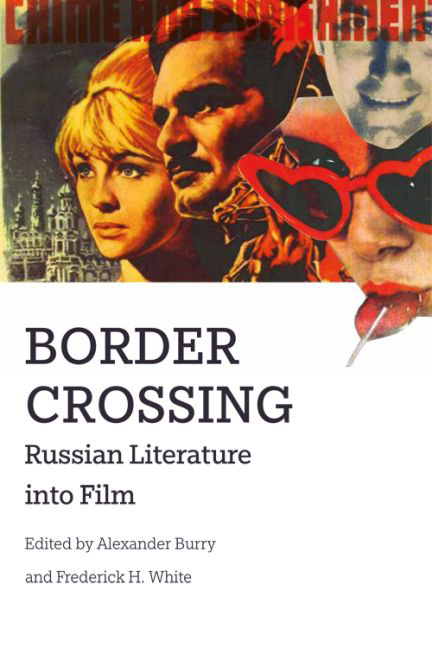Book contents
- Frontmatter
- Contents
- List of Figures
- Notes on the Contributors
- Introduction: Filming Russian Classics—Challenges and Opportunities
- 1 Across the Russian Border
- 2 Dostoevskii's “White Nights”: The Dreamer Goes Abroad
- 3 On Not Showing Dostoevskii's Work: Robert Bresson's Pickpocket
- 4 Stealing the Scene: Crime as Confession in Robert Bresson's Pickpocket
- 5 The Eye-deology of Trauma: Killing Anna Karenina Softly
- 6 “A Vicious Circle”: Karen Shakhnazarov's Ward no. 6
- 7 A Slap in the Face of American Taste: Transporting He Who Gets Slapped to American Audiences
- 8 Against Adaptation? The Strange Case of (Pod) Poruchik Kizhe
- 9 Chasing the Wealth: The Americanization of Il'f and Petrov's The Twelve Chairs
- 10 Fassbinder's Nabokov—From Text to Action: Repressed Homosexuality, Provocative Jewishness, and Anti-German Sentiment
- 11 “The Soviet Abroad (That We Lost)”: The Fate of Vasilii Aksenov's Cult Novel A Starry Ticket on Paper and on Screen
- Conclusion: Passport Control—Departing on a Cinematic Journey
- Bibliography
- Filmography
- Index
5 - The Eye-deology of Trauma: Killing Anna Karenina Softly
- Frontmatter
- Contents
- List of Figures
- Notes on the Contributors
- Introduction: Filming Russian Classics—Challenges and Opportunities
- 1 Across the Russian Border
- 2 Dostoevskii's “White Nights”: The Dreamer Goes Abroad
- 3 On Not Showing Dostoevskii's Work: Robert Bresson's Pickpocket
- 4 Stealing the Scene: Crime as Confession in Robert Bresson's Pickpocket
- 5 The Eye-deology of Trauma: Killing Anna Karenina Softly
- 6 “A Vicious Circle”: Karen Shakhnazarov's Ward no. 6
- 7 A Slap in the Face of American Taste: Transporting He Who Gets Slapped to American Audiences
- 8 Against Adaptation? The Strange Case of (Pod) Poruchik Kizhe
- 9 Chasing the Wealth: The Americanization of Il'f and Petrov's The Twelve Chairs
- 10 Fassbinder's Nabokov—From Text to Action: Repressed Homosexuality, Provocative Jewishness, and Anti-German Sentiment
- 11 “The Soviet Abroad (That We Lost)”: The Fate of Vasilii Aksenov's Cult Novel A Starry Ticket on Paper and on Screen
- Conclusion: Passport Control—Departing on a Cinematic Journey
- Bibliography
- Filmography
- Index
Summary
FROM PAGE TO SCREEN
How did it happen that world directors turned out to be so susceptible to Anna Karenina? First of all, from the standpoint of early Russian producers, this particular novel by Lev Tolstoi was a perfect candidate for a film adaptation because it enjoyed the status of a bestseller immediately upon its publication—it was even more successful than War and Peace. Popularizing literary classics was done in Russia in conjunction with the very democratic spirit of cinema—“its popular appeal, its educational and cultural orientation”— the features that were emphasized by early Russian producers and later by film historians. Turning to the classics did not guarantee high-quality films since, as Neya Zorkaya notes, “even the best films merely borrowed the story line and the names of the main characters,” but the fledgling genre aspired to explore the psychological and philosophical depths of a literary work, that “labyrinth of connections,” which, according to Tolstoi, is the essence of a novel.
James Griffith claims that in setting out to transform a novel into a movie, a filmmaker usually makes many choices along the same lines as those of the novelist. Having said this, Griffith admits that for all the changes people can cite in numerous adaptations,
a novel and its adaptation rarely share no more resemblance than the title—and one could argue such an “adaptation” exemplifies no more than a hastily purchased property. The average audience regards fidelity as a question of how much is left in: how much of the plot and how many of the characters survive the usual condensing of the novel's action.
Griffith argues that for the common filmgoer's notion of fidelity, the main objection usually refers not to ideas but to the practical inability of most films to include all of the events presented in a novel. As in this case, the hypertexts of Anna Karenina cannot adequately address all of the plotlines in Tolstoi's hypotext in the standard two-hour film.
- Type
- Chapter
- Information
- Border CrossingRussian Literature into Film, pp. 102 - 120Publisher: Edinburgh University PressPrint publication year: 2016



